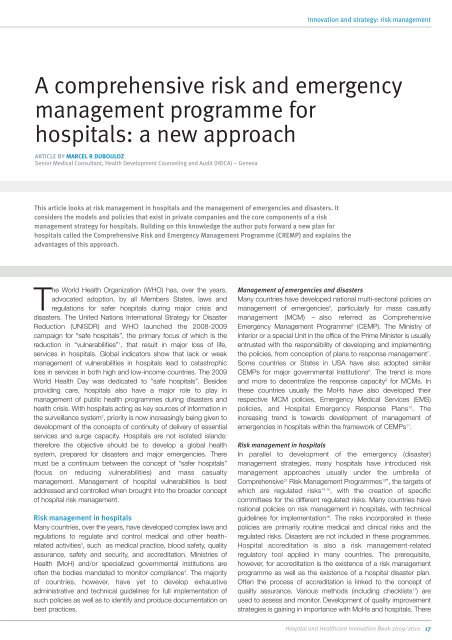Full document - International Hospital Federation
Full document - International Hospital Federation
Full document - International Hospital Federation
Create successful ePaper yourself
Turn your PDF publications into a flip-book with our unique Google optimized e-Paper software.
Innovation and strategy: risk management<br />
A comprehensive risk and emergency<br />
management programme for<br />
hospitals: a new approach<br />
ARTICLE BY MARCEL R DUBOULOZ<br />
Senior Medical Consultant, Health Development Counseling and Audit (HDCA) – Geneva<br />
This article looks at risk management in hospitals and the management of emergencies and disasters. It<br />
considers the models and policies that exist in private companies and the core components of a risk<br />
management strategy for hospitals. Building on this knowledge the author puts forward a new plan for<br />
hospitals called the Comprehensive Risk and Emergency Management Programme (CREMP) and explains the<br />
advantages of this approach.<br />
The World Health Organization (WHO) has, over the years,<br />
advocated adoption, by all Members States, laws and<br />
regulations for safer hospitals during major crisis and<br />
disasters. The United Nations <strong>International</strong> Strategy for Disaster<br />
Reduction (UNISDR) and WHO launched the 2008-2009<br />
campaign for “safe hospitals”, the primary focus of which is the<br />
reduction in “vulnerabilities” 1 , that result in major loss of life,<br />
services in hospitals. Global indicators show that lack or weak<br />
management of vulnerabilities in hospitals lead to catastrophic<br />
loss in services in both high and low-income countries. The 2009<br />
World Health Day was dedicated to “safe hospitals”. Besides<br />
providing care, hospitals also have a major role to play in<br />
management of public health programmes during disasters and<br />
health crisis. With hospitals acting as key sources of information in<br />
the surveillance system 2 , priority is now increasingly being given to<br />
development of the concepts of continuity of delivery of essential<br />
services and surge capacity. <strong>Hospital</strong>s are not isolated islands:<br />
therefore the objective should be to develop a global health<br />
system, prepared for disasters and major emergencies. There<br />
must be a continuum between the concept of “safer hospitals”<br />
(focus on reducing vulnerabilities) and mass casualty<br />
management. Management of hospital vulnerabilities is best<br />
addressed and controlled when brought into the broader concept<br />
of hospital risk management.<br />
Risk management in hospitals<br />
Many countries, over the years, have developed complex laws and<br />
regulations to regulate and control medical and other healthrelated<br />
activities 3 , such as medical practice, blood safety, quality<br />
assurance, safety and security, and accreditation. Ministries of<br />
Health (MoH) and/or specialized governmental institutions are<br />
often the bodies mandated to monitor compliance 4 . The majority<br />
of countries, however, have yet to develop exhaustive<br />
administrative and technical guidelines for full implementation of<br />
such policies as well as to identify and produce <strong>document</strong>ation on<br />
best practices.<br />
Management of emergencies and disasters<br />
Many countries have developed national multi-sectoral policies on<br />
management of emergencies 5 , particularly for mass casualty<br />
management (MCM) – also referred as Comprehensive<br />
Emergency Management Programme 6 (CEMP). The Ministry of<br />
Interior or a special Unit in the office of the Prime Minister is usually<br />
entrusted with the responsibility of developing and implementing<br />
the policies, from conception of plans to response management 7 .<br />
Some countries or States in USA have also adopted similar<br />
CEMPs for major governmental Institutions 8 . The trend is more<br />
and more to decentralize the response capacity 9 for MCMs. In<br />
these countries usually the MoHs have also developed their<br />
respective MCM policies, Emergency Medical Services (EMS)<br />
policies, and <strong>Hospital</strong> Emergency Response Plans 10 . The<br />
increasing trend is towards development of management of<br />
emergencies in hospitals within the framework of CEMPs 11 .<br />
Risk management in hospitals<br />
In parallel to development of the emergency (disaster)<br />
management strategies, many hospitals have introduced risk<br />
management approaches usually under the umbrella of<br />
Comprehensive 12 Risk Management Programmes 13 ”, the targets of<br />
which are regulated risks 14,15 , with the creation of specific<br />
committees for the different regulated risks. Many countries have<br />
national policies on risk management in hospitals, with technical<br />
guidelines for implementation 16 . The risks incorporated in these<br />
policies are primarily routine medical and clinical risks and the<br />
regulated risks. Disasters are not included in these programmes.<br />
<strong>Hospital</strong> accreditation is also a risk management-related<br />
regulatory tool applied in many countries. The prerequisite,<br />
however, for accreditation is the existence of a risk management<br />
programme as well as the existence of a hospital disaster plan.<br />
Often the process of accreditation is linked to the concept of<br />
quality assurance. Various methods (including checklists 17 ) are<br />
used to assess and monitor. Development of quality improvement<br />
strategies is gaining in importance with MoHs and hospitals. There<br />
<strong>Hospital</strong> and Healthcare Innovation Book 2009/2010 17

















